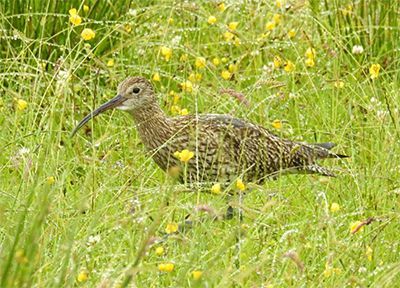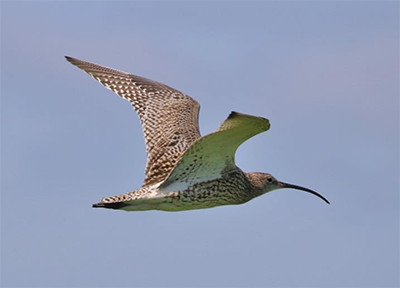News
Together we can make a difference for curlew!
Date Released: Thursday, December 14, 2017

At this time of year, with the nights closing in, Spring can seem very far away.
For hill farmers, however, the evocative call of the Eurasian Curlew will be a reminder that Winter is nearly over for another year. Around early March, the Curlew moves inland from our coasts to breed, remaining remarkably faithful to sites where they have bred before. Their preferred nesting sites are rough pasture and moorland, which provides a mix of both open patches to feed and dense bits of vegetation in which to hide their nests.
So why should we be concerned? The Curlew is in serious trouble. There are some parts of the UK and Ireland where farmers are no longer hearing their call. The numbers of breeding Curlew across the UK have dropped by 48% since the mid-90s. There are less than 150 pairs remaining in the Republic of Ireland, down from 3,750 – 4,000 pairs in the late 80’s which is a catastrophic decline of 96%. In southern and eastern England, recent surveys have shown there are fewer than 300 pairs remaining. Consequently, Curlew in Ireland and southern and eastern England are thought to be at real risk of imminent extinction, whilst declines in the UK more widely are also of serious concern. A potential disaster, not only for the UK and Ireland, but also the world as we are home to up to 27% of the global breeding population.
What is driving the decline? What seems to be the problem? Curlew are long-lived and should be able to maintain stable numbers if each pair raises one chick every couple of years. Unfortunately, in many areas their breeding success is much lower. The main causes of this lack of production are firstly loss of suitable habitat due to land-use change, such as agricultural practices and forestry. Secondly, predation, including that by foxes and crows, who often thrive in the heavily modified and fragmented landscapes we have shaped over the last few decades.

Curlew in hay meadow. Photo credit: Gavin Thomas
The challenge to respond is enormous particularly as Curlew are widely dispersed across landscapes. We cannot lose the Curlew so how can we make a difference at this sort of scale?
We have formed a UK and Ireland Curlew Action Group1. It is made up of a growing partnership of government agencies and conservation organisations, who all care about Curlew. We have come together to shape, drive and co-ordinate a programme of work across the UK so that we can make a difference for this species but also meet our international obligations, including the African Eurasian Waterbird Agreement and EU Birds Directive.
Our work includes:
Emergency action in the Republic of Ireland
The Curlew Conservation Programme is led the Agri-Ecology unit in the National Parks and Wildlife Service (NPWS). Their goal is to stop the Curlew population sliding further towards extinction by giving birds a better chance of rearing chicks. It involves locally based teams of advisors, champions and nest protection officers, working closely with landowners and other local interests, to protect Curlew nesting attempts and to improve habitat quality. There is also a strong research element to the programme and from 2018 onwards, a Post-doctoral researcher will be analysing the effectiveness of actions undertaken.
The annual report of the Curlew Conservation Programme for 2017 is available here.
Filling knowledge gaps so we can better understand the ecology of Curlew
The Curlew is now a very scarce breeding bird in Northern Ireland. It is estimated that only around 500 pairs remain, compared to 5,000 pairs in the 1980s. There are now few areas where Curlews are still relatively common. The best of these is the Glenwherry area in the southern Antrim Hills, where the species is regularly monitored by the RSPB. Glenwherry covers only a very small percentage of the total area of the Antrim Hills, however. This year, Northern Ireland Environment Agency staff joined the RSPB in a survey of Curlews in the remainder of the hills outside the study area. The results were alarming, with fewer than ten pairs being found outside the core area, which held approximately 50 pairs. These results not only emphasise the need to maintain suitable habitat in the areas that still have Curlews but also highlight the urgency with which habitat restoration and other conservation measures need to carried out in the parts of the Antrim Hills from which the species has been lost.
The GWCT is a running a number of different studies, exploring how breeding numbers and productivity of curlew, and other wader species, are influenced by levels of predator control, extent of heather burning and changes in grazing management. Some of this work is testing the predictions of their earlier experimental study at Otterburn, which demonstrated increases in breeding success and breeding numbers of ground-nesting birds, including Curlew, when predator control was undertaken. Current studies are ongoing but results are anticipated after one more season of data collection.
Ensuring important breeding sites for Curlew are appropriately protected and managed
Special Protection Areas under the EU Birds Directive provide protection for the most important sites for UK migratory bird species. Whilst 13 coastal SPAs have been designated for non-breeding Curlew, there is no SPA designated for Curlews in the breeding season. Although formal recommendations from JNCC and the country conservation agencies were made to government in 2001 to designate a further 12 non-breeding SPAs, and the North Pennines (the single most important site in England) as a SPA in the breeding season, these recommendations have yet to be implemented.
However, Environment Minister Thérèse Coffey recently noted, in a Westminster debate on the plight of the curlew, both that “it is time for action” and the need for “protecting important sites” – so hopefully action to designate these sites will occur very soon.
Increasing the number of chicks produced
Many of us are working with farmers to ensure farming operations support breeding success, in other words delaying mowing, and encouraging beneficial farming practices such as appropriate livestock grazing regimes. It is going to be important to ensure agri-environment funding continues and agri-environment schemes are improved post Brexit to support farmers to better manage land to benefit Curlew.
The RSPB is conducting a Trial Management Project to test the combination of habitat management and predator control interventions required to stabilise the breeding population of curlew. This will inform the future development of ‘curlew-friendly’ land management practices. More can be read here but it involves working at six sites across the four countries. The study has just completed one year where habitat management and predator control was undertaken at all the six trial management sites. It is too early to draw any conclusions but numbers seem to be broadly stable.
Natural England part-funds the five-year curlew trial management project under its Action for Birds in England partnership agreement with RSPB. It also commissioned BTO to undertake a national survey of upland in-bye farmland breeding curlew and other waders in 2016 to measure the success of agri-environment schemes in maintaining these species’ habitats and to identify breeding wader hot spots for future conservation effort. New initiatives in the Peak District and Northumberland are underway to deliver habitat management for Curlews and other waders through collaborative action by farmers and other landowners with agri-environment funding.
The needs of this bird are receiving particular attention by Environment Minister Coffey who has said “The curlew is too important to be lost from our world’s biodiversity.” Hopefully this Ministerial attention will directly lead to supportive conservation programmes that address identified conservation issues.
We simply cannot lose the call of the curlew. There is a lot at stake as we don’t want our Eurasian curlew to follow the shocking fate of two other species of Curlew, the Eskimo Curlew and the Slender-billed Curlew, both of which could possibly be extinct. We believe, however, that by all working together we can make a difference and improve the conservation prospects for this much-loved bird.

Curlew in flight. Photo credit: Neal Warnock
1The UK and Ireland Curlew Action Group brings together the Department of Agriculture and Rural Development Northern Ireland, Department of Culture, Heritage and the Gaeltacht Ireland, Joint Nature Conservation Committee, Natural England, Natural Resources Wales, Scottish Natural Heritage, BirdWatch Ireland, the British Trust for Ornithology, the Game and Wildlife Conservation Trust, the Royal Society for the Protection of Birds, and the Southern Curlew Forum.
